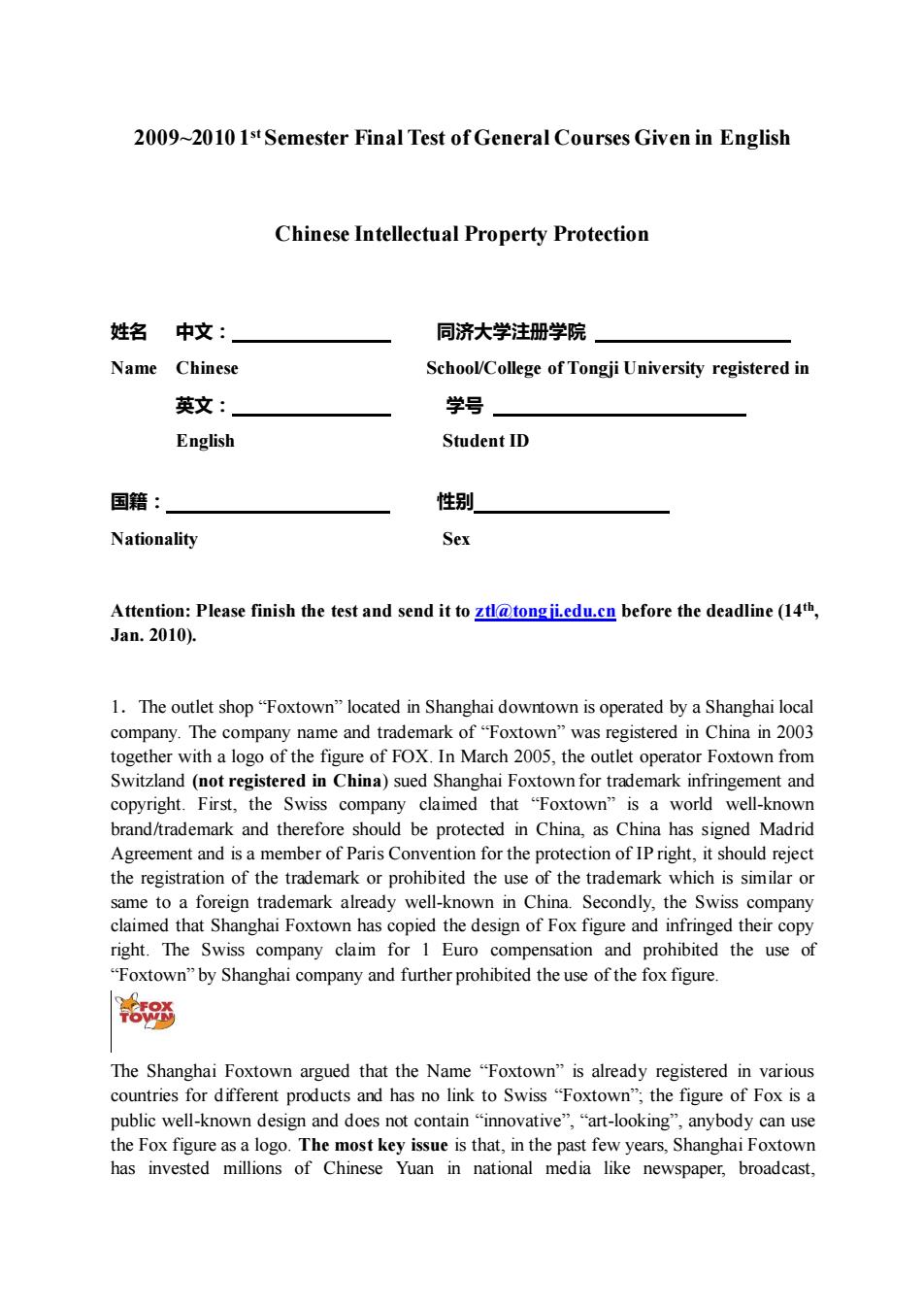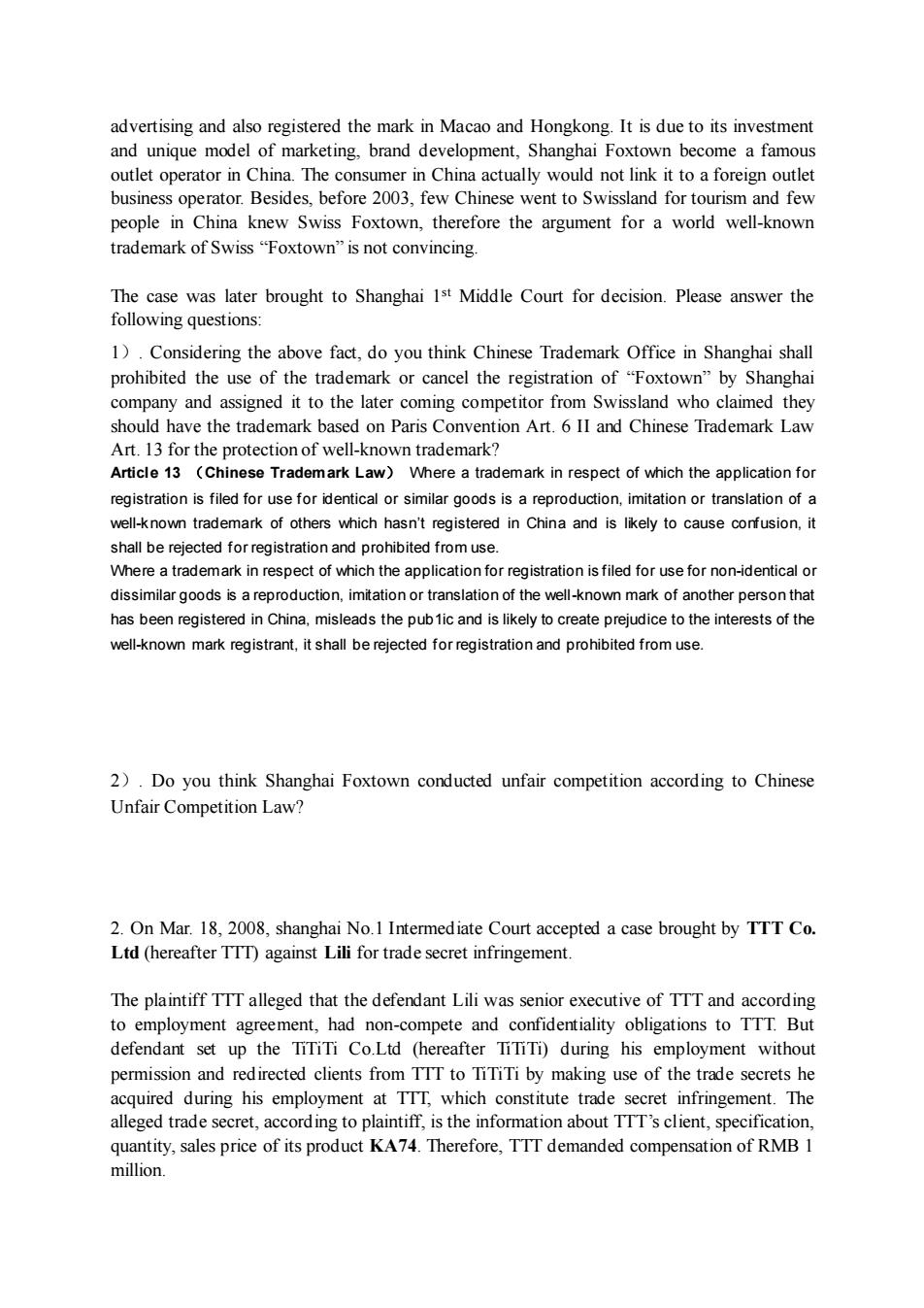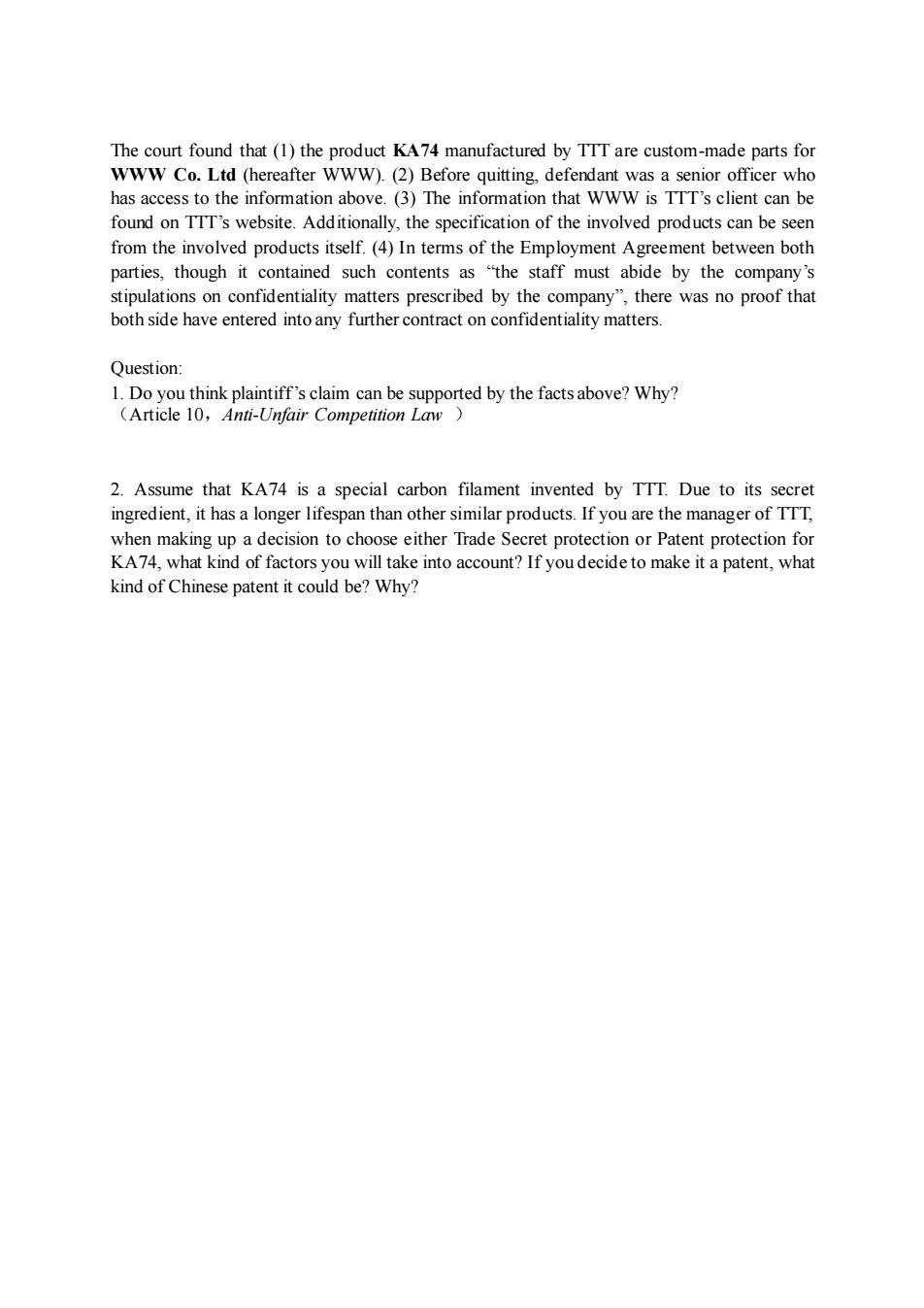
2009~2010 1st Semester Final Test of General Courses Given in English Chinese Intellectual Property Protection 姓名中文: 同济大学注册学院 Name Chinese SchoolCollege of Tongji University registered in 英文: 学号 English Student ID 国籍: 性别 Nationality Sex Attention:Please finish the test and send it to ztl@tongji.edu.cn before the deadline(14th, Jan.2010). 1.The outlet shop"Foxtown"located in Shanghai downtown is operated by a Shanghai local company.The company name and trademark of"Foxtown"was registered in China in 2003 together with a logo of the figure of FOX.In March 2005,the outlet operator Foxtown from Switzland(not registered in China)sued Shanghai Foxtown for trademark infringement and the S caimed that“Foxtown rorld well-knd brand/trademark and therefore should be protected in China,as China has signed Madrid Agreement and is a member of Paris Convention for the protection of IP right,it should reject the registration of the trademark or prohibited the use of the trademark which is similar or same to a foreign trademark already well-known in China.Secondly,the Swiss company claimed that Shanghai Foxtown has copied the design of Fox figure and infringed their c 0 right.The Swiss company claim for 1 Euro compensation and prohibited the use of "Foxtown"by Shanghai company and further prohibited the use of the fox figure. 6 The Shanghai Foxtown argued that the Name "registered in various countries for different products and has no link to Swiss"Foxtown":the figure of Fox is a public well--known design and does not contain“innovative”,“art--looking”,anybody can use the Fox figure as a logo.The most key issue is that,in the past few years,Shanghai Foxtown has invested millions of Chinese Yuan in national media like newspaper,broadcast
2009~2010 1 st Semester Final Test of General Courses Given in English Chinese Intellectual Property Protection 姓名 中文: 同济大学注册学院 Name Chinese School/College of Tongji University registered in 英文: 学号 English Student ID 国籍: 性别 Nationality Sex Attention: Please finish the test and send it to ztl@tongji.edu.cn before the deadline (14th , Jan. 2010). 1.The outlet shop “Foxtown” located in Shanghai downtown is operated by a Shanghai local company. The company name and trademark of “Foxtown” was registered in China in 2003 together with a logo of the figure of FOX. In March 2005, the outlet operator Foxtown from Switzland (not registered in China) sued Shanghai Foxtown for trademark infringement and copyright. First, the Swiss company claimed that “Foxtown” is a world well-known brand/trademark and therefore should be protected in China, as China has signed Madrid Agreement and is a member of Paris Convention for the protection of IP right, it should reject the registration of the trademark or prohibited the use of the trademark which is similar or same to a foreign trademark already well-known in China. Secondly, the Swiss company claimed that Shanghai Foxtown has copied the design of Fox figure and infringed their copy right. The Swiss company claim for 1 Euro compensation and prohibited the use of “Foxtown” by Shanghai company and further prohibited the use of the fox figure. The Shanghai Foxtown argued that the Name “Foxtown” is already registered in various countries for different products and has no link to Swiss “Foxtown”; the figure of Fox is a public well-known design and does not contain “innovative”, “art-looking”, anybody can use the Fox figure as a logo. The most key issue is that, in the past few years, Shanghai Foxtown has invested millions of Chinese Yuan in national media like newspaper, broadcast

advertising and also registered the mark in Macao and Hongkong.It is due to its investment and unique model of marketing.brand development,Shangha ai Foxtown become a famou outlet operator in China.The consumer in China actually would not link it to a foreign outlet business operator.Besides,before 2003,few Chinese went to Swissland for tourism and few people in China knew Swiss Foxtown,therefore the argument for a world well-known trademark of Swiss"Foxtown"is not convincing. The case was later brought to Shanghai 1st Middle Court for decision.Please answer the following questions: 1).Considering the above fact,do you think Chinese Trademark Office in Shanghai shall prohibited the use of the trademark or cancel the registration of "Foxtown"by Shanghai company and assigned it to the later coming competitor from Swissland who claimed they should have the k based on Pari ion Art.6 II and Chinese Trad ark Law rele 1c in repet of ich thepo for 13f on of w registration is filed for use for identical or similar goods is a reproduction,imitation or translation of a well-known trademark of others which hasn't registered in China and is likely to cause confusion,it shall be rejected for registration and prohibited from use. of whic n fo a ue app registration is filed for use for non-identical or dissimilar goods is a reproduction.imitation or translation of the well-known mark of another person tha has been registered in China,misleads the pub 1ic and is likely to create prejudice to the interests of the well-known mark registrant.it shall be rejected for registration and prohibited from use. 2).Do you think Shanghai Foxtown conducted unfair competition according to Chinese Unfair Competition Law 2.On Mar.18,2008,shanghai No.I Intermediate Court accepted a case brought by TTTCo. Ltd (hereafter TTT)against Lili for trade secret infringement. The plaintiff TIT alleged that the defendant Lili was senior executive of TIT and according to er ployment agre ent,had non-compete and confidentiality obligations to TTT.But permission and redirected clients from TIT to TiTiTi by making use of the trade secrets he acquired during his employment at TTT,which constitute trade secret infringement.The alleged trade secret,according to plaintiff,is the information about TTT's client,specification, quantity.sales price of its product KA74.Therefore,TTT demanded compensation of RMB 1
advertising and also registered the mark in Macao and Hongkong. It is due to its investment and unique model of marketing, brand development, Shanghai Foxtown become a famous outlet operator in China. The consumer in China actually would not link it to a foreign outlet business operator. Besides, before 2003, few Chinese went to Swissland for tourism and few people in China knew Swiss Foxtown, therefore the argument for a world well-known trademark of Swiss “Foxtown” is not convincing. The case was later brought to Shanghai 1st Middle Court for decision. Please answer the following questions: 1). Considering the above fact, do you think Chinese Trademark Office in Shanghai shall prohibited the use of the trademark or cancel the registration of “Foxtown” by Shanghai company and assigned it to the later coming competitor from Swissland who claimed they should have the trademark based on Paris Convention Art. 6 II and Chinese Trademark Law Art. 13 for the protection of well-known trademark? Article 13 (Chinese Trademark Law) Where a trademark in respect of which the application for registration is filed for use for identical or similar goods is a reproduction, imitation or translation of a well-known trademark of others which hasn’t registered in China and is likely to cause confusion, it shall be rejected for registration and prohibited from use. Where a trademark in respect of which the application for registration is filed for use for non-identical or dissimilar goods is a reproduction, imitation or translation of the well-known mark of another person that has been registered in China, misleads the pub1ic and is likely to create prejudice to the interests of the well-known mark registrant, it shall be rejected for registration and prohibited from use. 2). Do you think Shanghai Foxtown conducted unfair competition according to Chinese Unfair Competition Law? 2. On Mar. 18, 2008, shanghai No.1 Intermediate Court accepted a case brought by TTT Co. Ltd (hereafter TTT) against Lili for trade secret infringement. The plaintiff TTT alleged that the defendant Lili was senior executive of TTT and according to employment agreement, had non-compete and confidentiality obligations to TTT. But defendant set up the TiTiTi Co.Ltd (hereafter TiTiTi) during his employment without permission and redirected clients from TTT to TiTiTi by making use of the trade secrets he acquired during his employment at TTT, which constitute trade secret infringement. The alleged trade secret, according to plaintiff, is the information about TTT’s client, specification, quantity, sales price of its product KA74. Therefore, TTT demanded compensation of RMB 1 million

The court found that (1)the product KA74 manufactured by TTT are custom-made parts for WWW Co.Ltd (hereafter WwW).(2)Before quitting,defendant was a senior officer who has access to the information above.(3)The information that WWW is TTT's client can be found on TIT's website.Additionally,the specification of the involved products can be seen from the involved products itself.(4)In terms of the Employment Agreement between both parties,though it contained such contents as "the staff must abide by the company's stipulations on confidentiality matters prescribed by the company",there was no proof that both side have entered into any further contract on confidentiality matters. Question: 1.Do you think plaintiff's claim can be supported by the facts above?Why? (Article 10,Anti-Unfair Competition Law 2.Assume that KA74 is a special carbon filament invented by TTT.Due to its secret ingredient,it has a longer lifespan than other similar products.If you are the manager of TTT, when making up a decision to choose either Trade Secret protection or Patent protection for KA74,what kind of factors you will take into account?If you decide to make it a patent,what kind of Chinese patent it could be?Why?
The court found that (1) the product KA74 manufactured by TTT are custom-made parts for WWW Co. Ltd (hereafter WWW). (2) Before quitting, defendant was a senior officer who has access to the information above. (3) The information that WWW is TTT’s client can be found on TTT’s website. Additionally, the specification of the involved products can be seen from the involved products itself. (4) In terms of the Employment Agreement between both parties, though it contained such contents as “the staff must abide by the company’s stipulations on confidentiality matters prescribed by the company”, there was no proof that both side have entered into any further contract on confidentiality matters. Question: 1. Do you think plaintiff’s claim can be supported by the facts above? Why? (Article 10,Anti-Unfair Competition Law ) 2. Assume that KA74 is a special carbon filament invented by TTT. Due to its secret ingredient, it has a longer lifespan than other similar products. If you are the manager of TTT, when making up a decision to choose either Trade Secret protection or Patent protection for KA74, what kind of factors you will take into account? If you decide to make it a patent, what kind of Chinese patent it could be? Why?